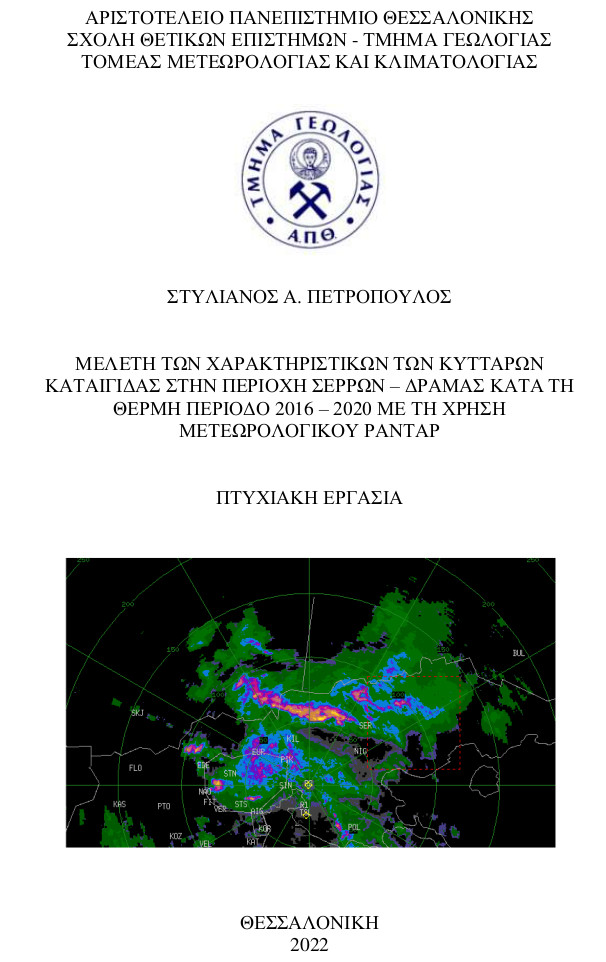
Μελέτη των χαρακτηριστικών των κυττάρων καταιγίδας στην περιοχή Σερρών-Δράμας κατά τη θερμή περίοδο 2016 – 2020 με τη χρήση μετεωρολογικού ραντάρ = Characteristics of storm cells in the study area of Serres – Drama (N. Greece) for the period May – September between 2016 – 2020, using weather radar.
Περίληψη
The need of studying and monitoring weather issues, developed new, modern methods to analyze and quantify precipitation characteristics. Weather radar is one of those new monitor equipment. Weather radar is ground equipment that detects storm cells. Storm cells are nebulae that can produce a significant amount of precipitation. The radar then, through an algorithm, quantifies the characteristics of these cells and writes down their speed, direction, duration, reflectivity and spatial characteristics, such as mass, volume, precipitation area, top and base of cells. In this bachelor thesis, a study is made to determine characteristics of the cells for the period May – September, between 2016 – 2020, in the study area of Serres – Drama, specifically for the Serres and Drama basins and the surrounding mountains. During that period the weather radar in Filiro, Thessaloniki is fully operational. In the first stage, the characteristics of the study area are mentioned, and the characteristics of the cells are described based on specific detection criteria and then, in the next stage, these characteristics are analyzed based on their monthly distribution and relative frequency. Results indicate that cell dynamical characteristics such as reflectivity and cloud top are observed during July and August while the maximum number of cells is observed in June. Cells tend to develop during the afternoon hours while their average duration does not exceed 40 minutes.
Πλήρες Κείμενο:
PDFΑναφορές
Cotton, W. R., and R. A. Anthes, 1989: Storm and Cloud Dynamics. Academic Press, Inc., San Diego, CA, 880pp.
Dixon,M. J., and G. Wiener, 1993: TITAN: Thunderstorm Identification, Tracking, Analysis and Nowcasting: Α Radar-based Methodology. J. Atmos. And Oceanic Technol., 10, 6, 785-797.
Meteoworld, 2015: Meteorological Radar at the World Radiocommunication Conference.
Roberts R.D., and S. Rutledge,2003: Nowcasting storm Initiation and Growth using GOES-8 and WSR-88D data. Wea. Forecasting, 18, Issue 4, 562-584.
Αριστοτέλειο Πανεπιστήμιο Θεσσαλονίκης, Σπυρίδης Α. – Κουταλού Β. Ο.Ε. – «ΥΕΤΟΣ», Περλέρος Β., Λιόνης Μ., Λεβογιάννης Μ.: Έλεγχος χημικής ποιότητας αρδευτικών υδάτων (επιφανειακών και υπόγειων) σε κλίμακα λεκανών απορροής ποταμών Μακεδονίας – Θράκης και Θεσσαλίας: Αποτελέσματα λεκάνης
Στρυμόνα: Αποτελέσματα λεκάνης Αγγίτη Δράμας: Υδρογεωλογικές εργασίες.
Βαβλιάκης Ε., 1981: Μελέτη των επιφανειών διάβρωσης, καρστικών, παγετώδων μορφών του όρους Μενοικίου (στην Α. Μακεδονία) από γεωμορφολογικής και μορφογενετικής πλευράς., Διδακτορική Διατριβή, σ.1-192.
ΓΕΑ – ΕΜΥ – Μετεωρολογικός Σταθμός Σερρών – 606: Μηνιαία στατιστικά.
Λιναρδάτου Γ. και Λιναρδάτου Δ., 2016: Ραντάρ: Εκπαιδευτικό Κείμενο Ακαδημιών Εμπορικού Ναυτικού.
Μακρογιάννης Τ.Ι. – Σαχσαμανόγλου Χ.Σ. , 2004: Μαθήματα Γενικής Μετεωρολογίας, 414pp.
Μπαλαφούτης Χ., 1977: Συμβολή εις την μελέτη του κλίματος της Μακεδονίας και Δυτικής Θράκης., Διδακτορική Διατριβή, σ.1-110.
Μπαμπζέλης Δ. , 2013: Διερεύνηση συνθηκών εφαρμογής προγραμμάτων αύξησης βροχής: Εφαρμογή στην ευρύτερη περιοχή της Θεσσαλίας., Διδακτορική Διατριβή, Αριστοτέλειο Πανεπιστήμιο Θεσσαλονίκης.
Μουντράκης Δ., 2010: Γεωλογία και Γεωτεκτονική εξέλιξη της Ελλάδα, 373pp.
Πανταζίδης Γ.,2014: Τεύχος τεχνικών δεδομένων: Γενικό Πολεοδομικό Σχέδιο (Γ.Π.Σ.) Δήμου Δράμας.
Παπαφιλίππου – Πέννου Ε., 2004: Δυναμική εξέλιξη και σύγχρονες εξωγενείς διεργασίες του υδρογραφικού συστήματος της ταφρολεκάνης Σερρών., Διδακτορική διατριβή, σ.1-238.
Σάγος Γ., 2018: Συστήματα ραντάρ και ηλεκτρονικού πολέμου.
Τσουκαλάς Ζ., 2006: Ραντάρ: Εκπαιδευτικό κείμενο Ανώτερων Δημόσιων Σχολών Εμπορικού Ναυτικού.
Ιστοσελίδες
www.windows2universe.org
www.3dsa.gr
www.stravon.gr
el.wikipedia.org
Εισερχόμενη Αναφορά
- Δεν υπάρχουν προς το παρόν εισερχόμενες αναφορές.
